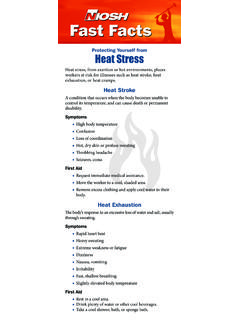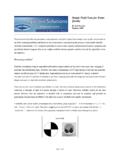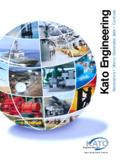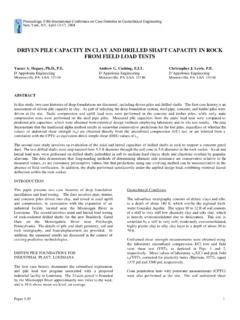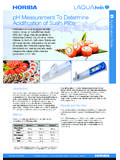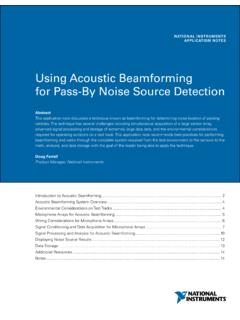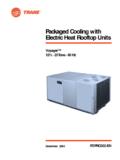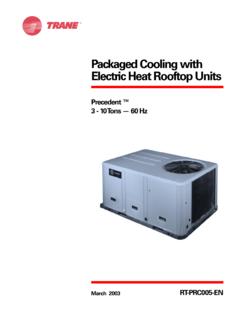Transcription of Chlorine Residual Testing
1 Chlorine Residual Testing Fact Sheet, CDC SWS Project 1 Chlorine Residual Testing The presence of Chlorine Residual in drinking water indicates that: 1) a sufficient amount of Chlorine was added initially to the water to inactivate the bacteria and some viruses that cause diarrheal disease; and, 2) the water is protected from recontamination during storage. The presence of free Residual Chlorine in drinking water is correlated with the absence of disease-causing organisms, and thus is a measure of the potability of water . This Fact Sheet describes: 1. The processes that occur when Chlorine is added to water , and the definitions involved with these processes; 2.
2 How and why the Safe water System project recommends Testing of free Chlorine ; 3. Methods to test free Chlorine in the field in developing countries. Definitions When Chlorine is added to drinking water , it proceeds through a series of reactions described below and depicted graphically on the next page. When Chlorine is added to water , some of the Chlorine reacts first with organic materials and metals in the water and is not available for disinfection (this is called the Chlorine demand of the water ). The remaining Chlorine concentration after the Chlorine demand is accounted for is called total Chlorine . Total Chlorine is further divided into: 1) the amount of Chlorine that has reacted with nitrates and is unavailable for disinfection which is called combined Chlorine and, 2) the free Chlorine , which is the Chlorine available to inactivate disease-causing organisms, and thus a measure to determine the potability of water .
3 For example, if using completing clean water the Chlorine demand will be zero, and there will be no nitrates present, so no combined Chlorine will be present. Thus, the free Chlorine concentration will be equal to the concentration of Chlorine initially added. In natural waters, especially surface water supplies such as rivers, organic material will exert a Chlorine demand, and nitrates will form combined Chlorine . Thus, the free Chlorine concentration will be less than the concentration of Chlorine initially added. Chlorine Residual Testing Fact Sheet, CDC SWS Project 2 Chlorine Addition Flow Chart Chlorine Added Initial Chlorine concentration added to water Free Chlorine Concentration of Chlorine available for disinfection Combined Chlorine Concentration of Chlorine combined with nitrogen in the water and unavailable for disinfection Total Chlorine Remaining Chlorine concentration after Chlorine demand of water Chlorine Demand Reactions with organic material, metals, other compounds present in water prior to disinfection Chlorine Residual Testing Fact Sheet, CDC SWS Project 3 Why Do We Test Free Chlorine in Drinking water ?
4 The SWS project recommends Testing free Chlorine in two circumstances: To conduct dosage Testing in project areas prior to the start of a program. To monitor and evaluate projects by Testing stored water in households. The goal of dosage Testing is to determine how much sodium hypochlorite solution to add to water that will be used for drinking to maintain free Chlorine Residual in the water for the average time of storage of water in the household (typically 4-24 hours). This goal differs from the goal of infrastructure-based (piped) water treatment systems, whose aim is effective disinfection at the endpoints ( , water taps) of the system: defined by the WHO (1993) as: a Residual concentration of free Chlorine of greater than or equal to mg/litre after at least 30 minutes contact time at pH less than This definition is only appropriate when users drink water directly from the flowing tap.
5 A free Chlorine level of mg/Liter of free Chlorine will be enough Residual to maintain the quality of water through the distribution network, but is most likely not adequate to maintain the quality of the water when this water is stored in the home in a bucket or jerry can for 24 hours. Thus, the SWS program recommends in our dosage Testing that: 1. At 30 minutes after the addition of sodium hypochlorite there should be no more than mg/L of free Chlorine Residual present (this ensures the water does not have an unpleasant taste or odor). 2. At 24 hours after the addition of sodium hypochlorite to containers that are used by families to store water there should be a minimum of mg/L of free Chlorine Residual present (this ensures microbiologically clean water ).
6 The SWS project methodology leads to Chlorine Residual levels that are significantly lower than the WHO guideline value for free Chlorine Residual in drinking water , which is 5 mg/L value. The SWS project recommends Testing free Chlorine in homes of SWS users for evaluation of whether or not users are using the system and if they are using it correctly. Households can be visited and spot checked to determine if, and how much, free Chlorine Residual is present in their drinking water . This approach is very useful for program monitoring because the presence of free Chlorine residuals in stored water obtained from an unchlorinated source is an objective measure that people are using the hypochlorite solution.
7 Chlorine Residual Testing Fact Sheet, CDC SWS Project 4 Methods to Test Free Chlorine in the field in Developing Countries There are three main methods to test free Chlorine Residual in drinking water in the field in developing countries: 1) Pool test kits, 2) Color-wheel test kits, and 3) Digital colorimeters. All three methods depend on a color change to identify the presence of Chlorine , and a measurement of the intensity of that color to determine how much Chlorine is present. 1. Pool Test Kits The first option for Testing uses a liquid chemcial OTO (othotolidine) that causes a color change to yellow in the presence of total Chlorine .
8 You simply fill a tube with water , add 1-5 drops of the solution, and look for the color change. These kits are sold in many stores as a way to test the concentration of total Chlorine in swimming pool water . This method does not measure free Chlorine . Benefits of the pool test kits are: Low cost Very easy to use Drawbacks of the pool test kits are: Degradation of the OTO solution that causes inaccurate readings over time Generally not reliable quantitative results Lack of calibration and standardization How to order and cost information: Many large home supply stores, and pool stores Approximately $5-20 USD each Chlorine Residual Testing Fact Sheet, CDC SWS Project 5 2.
9 Color-wheel Test Kit Color wheel test kits use a powder or tablet chemical DPD (N,N diethyl-p-phenylene diamine) that causes a color change to pink in the presence of Chlorine . The color wheels are simpler and less expensive than digital meters because to measure the intensity of the color change, the field worker uses a color wheel to visually match the color to a numerical free or total Chlorine reading. The test kit can be used to measure free Chlorine and/or total Chlorine , with a range of 0 mg/L, equivalent to 0 ppm (parts per million). Benefits of the color-wheel test kits are: Accurate readings if used properly Low cost Drawbacks of the color-wheel test kits are: Potential for user error Lack of calibration and standardization How to order and cost information: Hach Company Approximately $40 Chlorine Residual Testing Fact Sheet, CDC SWS Project 6 3.
10 Digital Colorimeters Digital colorimeters are the most accurate way to measure free Chlorine and/or total Chlorine Residual in the field in developing countries. These colorimeters use the following method: 1) addition of DPD tablets or powder into a vial of sample water that causes a color change to pink; and, 2) insertion of the vial into a meter that reads the intensity of the color change by emitting a wavelength of light and automatically determining and displaying the color intensity (the free and/or total Chlorine Residual ) digitally. The range of the meter is 0 - 4 mg/L, equivalent to 0 - 4 ppm (parts per million).









